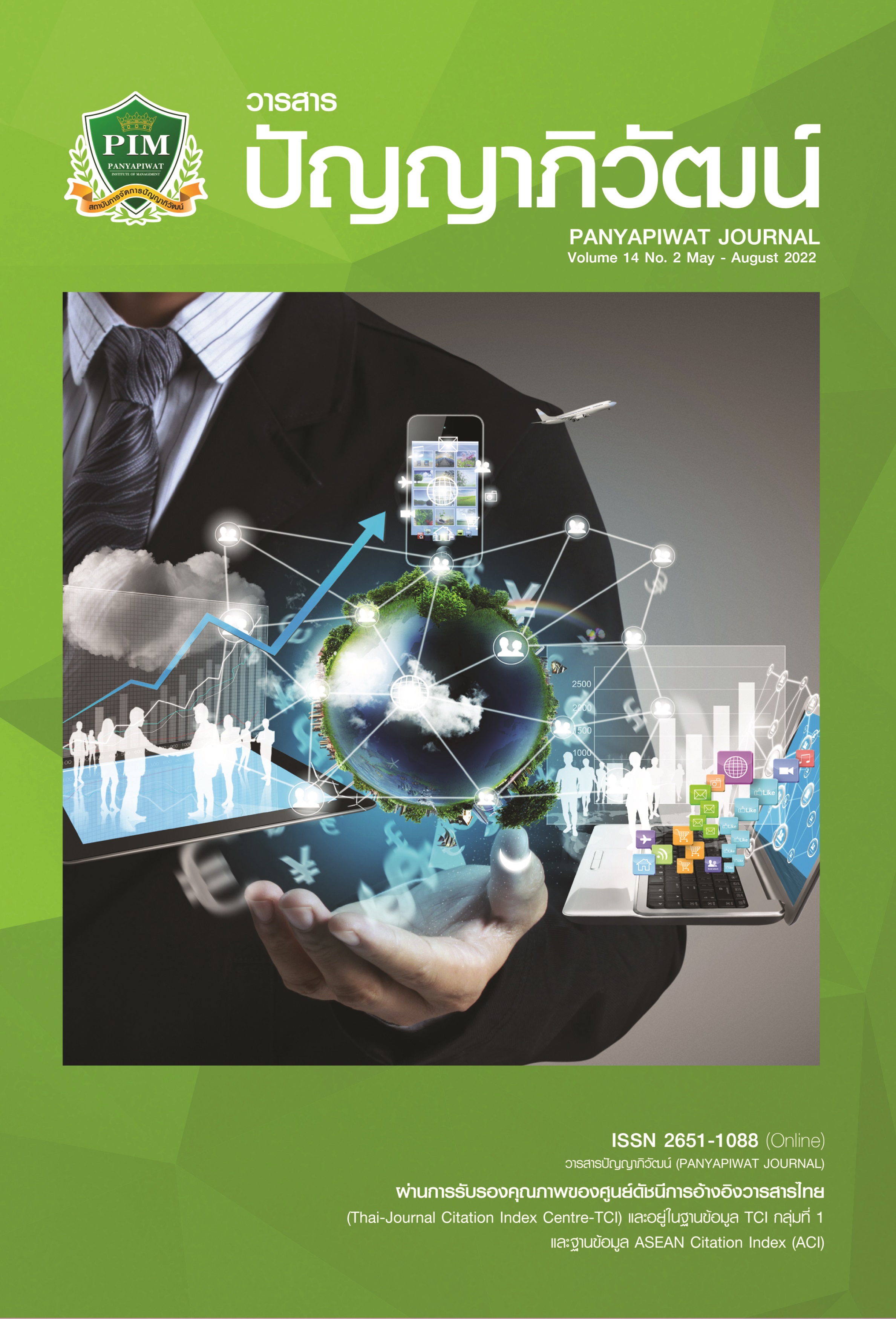ความสัมพันธ์ระหว่างสภาพคล่องและความสามารถในการทำกำไรของธุรกิจโรงแรมที่จดทะเบียนในตลาดหลักทรัพย์แห่งประเทศไทย
Main Article Content
บทคัดย่อ
งานวิจัยเรื่องนี้มีวัตถุประสงค์เพื่อทำการวิเคราะห์ความสัมพันธ์ระหว่างสภาพคล่องและความสามารถในการทำกำไรของธุรกิจโรงแรมที่จดทะเบียนในตลาดหลักทรัพย์แห่งประเทศไทยจำนวน 9 แห่ง ระหว่างปีพ.ศ. 2543-2562 โดยอาศัยการวิเคราะห์ Fixed Effects Regression และ Random Effects Regression สภาพคล่องในงานวิจัยเรื่องนี้วัดโดยอัตราส่วนทางการเงิน 2 ตัว ได้แก่ อัตราส่วนเงินทุนหมุนเวียนและอัตราส่วนเงินทุนหมุนเวียนเร็ว ในขณะที่ความสามารถในการทำกำไรวัดโดยอัตราส่วนทางการเงิน 2 ตัว ได้แก่ อัตราผลตอบแทนต่อสินทรัพย์รวมและอัตรากำไรสุทธิ จากการศึกษาพบว่า ทั้งอัตราส่วนเงินทุนหมุนเวียนและอัตราส่วนเงินทุนหมุนเวียนเร็วมีความสัมพันธ์ในเชิงบวกกับอัตราผลตอบแทนต่อสินทรัพย์รวม โดยหากอัตราส่วนเงินทุนหมุนเวียนและอัตราส่วนเงินทุนหมุนเวียนเร็วสูงขึ้น 1 เท่า จะทำให้อัตราผลตอบแทนต่อสินทรัพย์รวมของธุรกิจโรงแรมที่ทำการศึกษาสูงขึ้นร้อยละ 1.305 และ 1.301 ตามลำดับ ในขณะที่ทั้งอัตราส่วนเงินทุนหมุนเวียนและอัตราส่วนเงินทุนหมุนเวียนเร็วไม่มีความสัมพันธ์กับอัตรากำไรสุทธิแต่อย่างใด อย่างไรก็ตาม สามารถสรุปได้ว่า สภาพคล่องและความสามารถในการทำกำไรมีความสัมพันธ์กันในเชิงบวก ดังนั้นการบริหารสภาพคล่องที่เหมาะสมจะช่วยให้กิจการมีความสามารถในการทำกำไรสูงขึ้นได้
Article Details

อนุญาตภายใต้เงื่อนไข Creative Commons Attribution-NonCommercial-NoDerivatives 4.0 International License.
“ข้าพเจ้าและผู้เขียนร่วม (ถ้ามี) ขอรับรองว่า บทความที่เสนอมานี้ยังไม่เคยได้รับการตีพิมพ์และไม่ได้อยู่ระหว่างกระบวนการพิจารณาลงตีพิมพ์ในวารสารหรือแหล่งเผยแพร่อื่นใด ข้าพเจ้าและผู้เขียนร่วมยอมรับหลักเกณฑ์การพิจารณาต้นฉบับ ทั้งยินยอมให้กองบรรณาธิการมีสิทธิ์พิจารณาและตรวจแก้ต้นฉบับได้ตามที่เห็นสมควร พร้อมนี้ขอมอบลิขสิทธิ์บทความที่ได้รับการตีพิมพ์ให้แก่สถาบันการจัดการปัญญาภิวัฒน์หากมีการฟ้องร้องเรื่องการละเมิดลิขสิทธิ์เกี่ยวกับภาพ กราฟ ข้อความส่วนใดส่วนหนึ่งและ/หรือข้อคิดเห็นที่ปรากฏในบทความข้าพเจ้าและผู้เขียนร่วมยินยอมรับผิดชอบแต่เพียงฝ่ายเดียว”
เอกสารอ้างอิง
Ahmad, R. (2016). A study of relationship between liquidity and profitability of Standard Chartered Bank Pakistan: Analysis of financial statement approach. Global Journal of Management and Business Research, 16(1), 76-82.
Al-Qadi, N. S., & Khanji, I. M. (2018). Relationship between liquidity and profitability: An empirical study of trade service sector in Jordan. Research Journal of Finance and Accounting, 9(7), 153-157.
Bibi, N., & Amjad, S. (2017). The relationship between liquidity and firms’ profitability: A case study of Karachi stock exchange. Asian Journal of Finance & Accounting, 9(1), 54-67.
Dao, B. T. T., & Nguyen, D. P. (2020). Determinants of profitability of commercial banks in Vietnam, Malaysia and Thailand. Asian Journal of Finance, Economics and Business, 7(4), 133-143.
Durrah, O., Rahman, A. A., Jamil, S. A., & Ghafeer, N. A. (2016). Exploring the relationship between liquidity ratios and indicators of financial performance: An analytical study on food industrial companies listed in Amman Bursa. International Journal of Economics and Financial, 6(2), 435-441.
Irawan, A., & Faturohman, T. (2015). A study of liquidity and profitability relationship: Evidence from Indonesian capital market. International Journal of Management and Applied Science (IJMAS), 1(9), 87-91.
Jarungklin, J. (2011). The factors determining profitability of food and beverage business listed in the stock exchange of Thailand [Mater’s independent study]. Bangkok University. [in Thai]
Kobika, R. (2018). Liquidity management and profitability: A case study analysis of listed manufacturing companies in Srilanka. Global Scientific Journal, 6(9), 484-494.
Lartey, V. C., Antwi, S., & Boadi, E. K. (2013). The relationship between liquidity and profitability of listed banks in Ghana. International Journal of Business and Social Science, 4(3), 48-56.
Megaladevi, P. (2018). A study on the impact of liquidity ratios on profitability of selected cement companies in India. ICTACT Journal of Management Studies, 4(4), 860-864.
Mohanty, B., & Mehrotra, S. (2018). Relationship between liquidity and profitability: An exploratory study of SMEs in India. Emerging Economy Studies, 4(2), 169-181.
Muangjaroen, A. (2018). The factors affecting the profitability of energy industry and public utility listed companies in the stock exchange of Thailand [Master’s thesis]. Rajamangala University of Technology Thanyaburi. [in Thai]
Olarevuju, O. M., & Adeyemi, O. K. (2015). Causal relationship between liquidity and profitability of Nigerian deposit money banks. International Journal of Academic Research in Accounting, Finance and Management Sciences, 5(2), 165-171.
Ross, S. (2019). Liquidity management in business and investing. Investopedia. https://www.investopedia.com/ask/answers/122714/what-liquidity-management.asp
Ross, S., Westerfield, R., & Jaffe, J. (2006). Corporate finance (8th ed.). McGraw-Hill.
Sattar, A. R. (2020). Impact of liquidity on profitability: A case of comparison in textile sector in Pakistan between 2014 and 2015. European Online Journal of Natural and Social Sciences, 9(1), 13-19.
Umobong, A. A. (2015). Assessing the impact of liquidity and profitability ratios on growth of profits in pharmaceutical firms in Nigeria. European-American Journal, 3(1), 97-114.
Waleed, A., Pasha, A., & Akhtar, A. (2016). Exploring the impact of liquidity on probability: Evidence from banking sector of Pakistan. Journal of Internet Banking and Commerce, 21(3), 1-12.
Wooldridge, J. M. (2003). Introduction econometrics: A modern approach. South-Western Thomson Learning.


